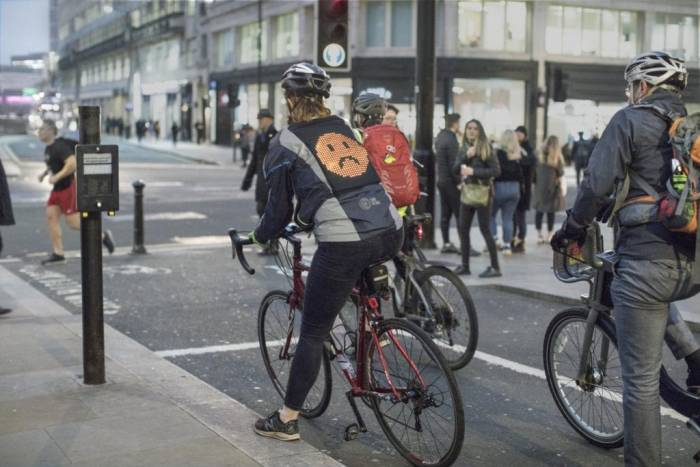As part of its Share The Road campaign, Ford built a concept jacket for cyclists that shares emojis and turn signals with drivers behind them. But the giant question is, why?
Happy face, angry face, neutral face, left and right arrows, and a hazard signal: You can say a lot with just a few symbols.
Ford today released a video (below), images, and a lot of marketing copy about a jacket that will likely never be produced. The concept product is a jacket with a large LED mesh panel on its back to display symbols to drivers behind cyclists.
The concept is not entirely unique, although this is the first time we’ve seen the space on the back of a jacket used to share signals. Other brands, such as Lumos, make bike helmets with turn signals and brake lights. And just last week at The Pitch, upstart Intentful Motion made a case for its bike lights that integrate into your existing bicycle and function as brake lights and turn signals.
https://youtu.be/g756nqX-jUU
So clearly, the idea has merit. As Ford notes in its press release, emojis convey powerful messages in a very small amount of space.
“This jacket,” Tilburg University professor Neil Cohn explained in a statement, “allows riders to express their feelings and creates an important emotional link between them and other road users.”
It’s a nice sentiment. So why, then, does Ford not mention the price of the jacket or when you can buy one? Most likely because it will never manufacture the jacket and that it’s just part of a large, coordinated public relations campaign known as Share The Road.
Share The Road: Lipservice vs. Action
On the surface, Share The Road is a campaign where Ford says, literally, “roads are for sharing.” It breaks down “how you can do your bit,” has a virtual reality view of what it’s like to ride a bike in heavy traffic, and even discusses a few real-world changes the company is making.
For example, Ford’s Smart Mobility Plan “incorporates vehicle sharing and e-bikes for commuters and commercial users. The Plan also includes FordPass cycle hire and crowd-sourced Chariot shuttle buses.”
But that single webpage is where the plan stops. Where are the public-private infrastructure improvements? Where is long-range planning? And where, oh where, can I buy this jacket?
Well, from what I can tell from the dozens of media articles covering this product release lock-step with Ford’s messaging, you can’t. And that’s a pretty good hint that Ford has already completed its mission with this campaign — to make itself look like it’s trying to make cycling safer while putting forth the bare minimum in terms of resources.
What Would Actually Make a Difference
Ford already knows what it can do to improve safety for cyclists. As it notes in its campaign, “Taking a fresh look at transport and finding smarter ways to get people around can make a big difference, particularly in busy cities with poor air quality and increasing congestion.”
And I don’t want to hate on the brand too much. Heck, I drive an F-150 and love it for all my mountain adventures.
But I also have pretty much given up on commuting by bike in Denver, even though I only live about 3 miles from work. Why? Because I don’t want to get hit by a car.
Bike-car accident fatalities are a weekly occurrence in Denver, a city that entirely fits Ford’s rubric about “smarter ways” above.
But where is Ford’s investment here? Instead of a fluffy campaign about a jacket that nobody will ever wear, where is the public-private partnership? If it cares so much about cyclists, why is it not sending engineers to help design better bikeways around the country, especially in cities like this one?
It’s obviously not in Ford’s interest to do so. There’s no profit to be had in remodeling our urban infrastructure with cyclists in mind, especially for a massive automaker. And I don’t really blame Ford for wanting to cast itself in a positive light with cyclists, most of whom also probably drive a car or truck more often than they ride a bike.
But it’s hard to swallow dozens of publications feeding me the same line about Ford’s jacket being a solution to cyclist fatalities. It’s not going to stop the texting driver from swerving into the bike lane, and it’s not going to keep a raging commuter from running a red light. And in the case of an accident, it won’t keep the cyclist from losing the battle every single time.
So I’ll keep driving to work most days except when feeling particularly brave. And I’ll look forward to the day a brand like Ford will sit down with city planners and work toward a real, viable solution to urban transportation that puts the human first.









